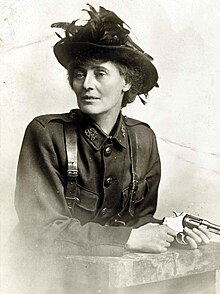
Back كونستانس ماركيفيتش Arabic كونستانس ماركيڤيكز ARZ Constance Markievicz AST Constance Markievicz BCL Constance Markievicz Catalan Constance Markieviczová Czech Constance Markievicz Welsh Constance Markiewicz German Constance Markievicz Spanish Constance Markievicz Basque
Constance Markievicz | |
|---|---|
 Markievicz in her Irish Citizen Army uniform | |
| Minister for Labour | |
| In office April 1919 – January 1922 | |
| Preceded by | New office |
| Succeeded by | Joseph McGrath |
| Teachta Dála | |
| In office August 1923 – 15 July 1927 | |
| In office May 1921 – June 1922 | |
| Constituency | Dublin South |
| In office December 1918 – May 1921 | |
| Constituency | Dublin St Patrick's |
| Member of Parliament | |
| In office 28 December 1918 – 15 November 1922 | |
| Preceded by | William Field |
| Succeeded by | Constituency abolished |
| Constituency | Dublin St Patrick's |
| Personal details | |
| Born | Constance Georgine Gore-Booth 4 February 1868 London, England |
| Died | 15 July 1927 (aged 59) Dublin, Ireland |
| Resting place | Glasnevin Cemetery, Dublin, Ireland |
| Political party |
|
| Spouse | Casimir Markievicz (m. 1900) |
| Relations | Eva Gore-Booth (Sister) |
| Children | Maeve Markievicz (1901–1962) |
| Parents |
|
| Military service | |
| Allegiance | |
| Years of service | 1913–1923 |
| Rank | Lieutenant[1] |
| Battles/wars | |
| Part of a series on |
| Irish republicanism |
|---|
 |
Constance Georgine Markievicz (Polish: Markiewicz [marˈkʲɛvitʂ]; née Gore-Booth; 4 February 1868 – 15 July 1927), also known as Countess Markievicz and Madame Markievicz,[2] was an Irish politician, revolutionary, nationalist, suffragist, socialist who was the first woman elected to the Westminster Parliament. She was elected Minister for Labour in the First Dáil, becoming the second female cabinet minister in Europe. She served as a Teachta Dála for the Dublin South constituency from 1921 to 1922 and 1923 to 1927. She was a Member of Parliament (MP) for Dublin St Patrick's from 1918 to 1922.
A founding member of Fianna Éireann, Cumann na mBan and the Irish Citizen Army, she took part in the Easter Rising in 1916, when Irish republicans attempted to end British rule and establish an Irish Republic. She was sentenced to death but her sentence was commuted to life imprisonment[3] on the grounds of her sex. On 28 December 1918, she was the first woman elected to the UK House of Commons,[4] though, being in Holloway Prison at the time and in accordance with party policy, she did not take her seat. Instead, she and the other Sinn Féin MPs (as TDs) formed the first Dáil Éireann. She was also one of the first women in the world to hold a cabinet position, as Minister for Labour, from 1919 to 1922.[a]
Markievicz supported the anti-Treaty stance in the Irish Civil War. She continued as an (abstentionist) Dáil member for Sinn Féin until 1926 when she became a founding member of Fianna Fáil. She died in 1927.
- ^ Bureau of Military History, Winess Statement 1666 [1] Archived 27 February 2015 at the Wayback Machine (Fr. T. O'Donoghue), p. 8
- ^ "Sligo and Madame Markievicz". The Irish Times. Dublin. 29 June 1917.
- ^ British National Archives WO 35/211
- ^ Cite error: The named reference
dec28was invoked but never defined (see the help page).
Cite error: There are <ref group=lower-alpha> tags or {{efn}} templates on this page, but the references will not show without a {{reflist|group=lower-alpha}} template or {{notelist}} template (see the help page).